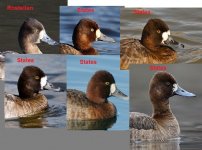As some of you may be interested in another perspective on this bird I am copying a posting I made on the Irish Birdnet this morning, where a discussion on the Rostellan Aythya started a few days ago.
Being one of a number of people who, independently, raised questions about this bird's identity I'd like to offer a summary of what concerns me about it being recorded as a Lesser Scaup.
BILL PATTERN: Bill patterns of female (especially juvenile female) Aythya ducks often do not conform to what might be considered the 'text book' pattern. To a certain extent this can be attributed to individual variation, a large part of which at any given time is due to the differing rates at which individual birds develop an adult-type bill pattern. An added complication is that it can be extremely difficult to determine exactly what pattern (if any) there is on darker-billed birds, where the light striking the complex contours of the bill can obscure or obliterate subtle shades of lighter and darker grey, especially when the bill is wet.
It is not unusual for first-year Lesser Scaups to show dark either side of the dark nail to give a more fan-shaped dark tip. The almost 'dipped-in-ink' dark bill tip exhibited by the Rostellan bird may perhaps be matched by the odd Lesser Scaup, but it is much more usual in Tufted Duck.
HEAD SHAPE: While the 'classic' head shape of Lesser Scaup (with a high peak at the rear) is very characteristic, Tufted Ducks, perhaps especially young birds with still undeveloped but growing 'tufts' can present a real pitfall for the unwary. At the risk of over analysing the photos of the Rostellan bird, it looks to me as if the feathers of the rear crown have 'taken off' in advance of those of the forecrown, thereby producing a head shape that at times is very reminiscent of Lesser Scaup. A range of photos, however, indicate that at other times it is much less convincing than I'd expect in a true Lesser Scaup (and not just prior to diving activity, when all diving ducks have a tendency to flatten their crown feathers somewhat).
UPPERPARTS & FLANKS: I think the strong contrast between the uniformly dark upperparts, which show no trace of lighter vermiculation, and the much lighter flank panel is the most striking feature of this bird that is difficult to reconcile with Lesser Scaup. Of course, the vermiculation of the upperparts feathers that gives adult female Lesser and Greater Scaups their characteristic greyish-bodied look is not shown by juveniles of either species, but Lessers (especially) in juvenile plumage tend to have much less contrast between the flank and the upperparts than that shown by the Rostellan bird; such contrast is often seen in Tufted Duck. I would quite like to be proven wrong on this last point, since in recent years I have become concerned that a female 'Lesser Scaup' I observed on the North Slob, Wexford in January 1998 (which my coloured field-sketches indicate had what I now regard as a more Tufted Duck-like flank) may not have had quite as good credentials as we believed at the time! Unfortunately it was never close enough to photograph, so I have no means of verifying the accuracy of my field observations.
So, if the Rostellan bird is not a Lesser Scaup, is it a hybrid? Perhaps. Given the relative frequency with which hybrid Aytha ducks occur, and the likelihood that many less obvious second and subsequent generation back crosses may go unnoticed, it is very difficult to draw a clear line between the limit of variation in pure Tufted Duck, and unusual appearance that is attributable to some degree of hybrid influence. In order to make a case for the Rostellan duck being a hybrid there would need to be some firm indication of a trait that falls outside the range of variation that can be observed in (presumed) pure Tufted Ducks. I don’t see anything about this bird that I would consider outside the variation I see in Tufted Duck, but I could well be missing something.
My thanks to all the photographers who made available their photos of this bird, especially Mike O' Keeffe and Jim Wilson.
Regards,
Killian Mullarney






